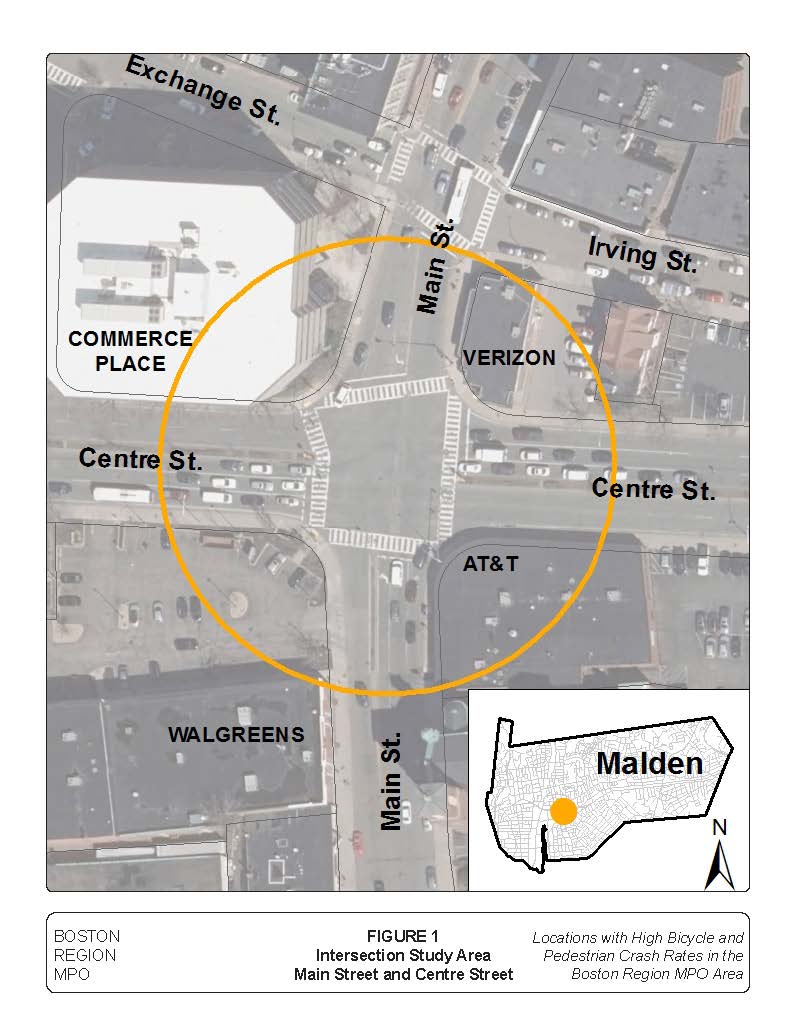
Technical Memorandum
DATE: May 6, 2021
TO: Michelle Romero and Yem Lip, City of Malden
FROM: Casey Claude, MPO Staff
RE: Locations with High Bicycle and Pedestrian Crash Rates in the Boston Region Metropolitan Planning Organization (MPO) Area: Main Street and Centre Street in Malden
This memorandum summarizes the analyses and improvement strategies for the intersection of Main Street and Centre Street in Malden.
This memorandum contains the following sections:
The memorandum also includes technical appendices that contain data and methods applied in the study.
The purpose of the Locations with High Bicycle and Pedestrian Crash Rates in the Boston Region MPO Area study is to examine safety, mobility, and comfort issues for bicycle and pedestrian travel at intersections in the Boston MPO region. The intent of the study is twofold: (1) Study high crash locations to understand what is contributing to the danger of walking and bicycling at selected intersections, and (2) identify features of the physical environment in need of improvement for the safety and comfort of pedestrian and bicycle travel. This study supports the MPO’s visions and goals, which include increasing transportation safety, maintaining the transportation system, advancing mobility, and reducing vehicle emissions. This work also gives the communities in which the intersections are located the opportunity to look at the needs of the studied intersections, starting at the conceptual level, before the municipality commits funds for design and engineering. Eventually, if the project qualifies for federal funds, this documentation will be useful for the Massachusetts Department of Transportation (MassDOT).
Following a selection process based on bicycle and pedestrian crash information, equity considerations, and implementation potential, the following three locations were chosen for study:
The location in Malden was selected because the intersection at Centre Street and Main Street is located within a Highway Safety Improvement Program (HSIP) eligible pedestrian crash cluster.1 Although it is the one intersection chosen for this study that isn’t located within an HSIP bicycle crash cluster, the intersection is located within a transportation analysis zone (TAZ) that exceeds the regional thresholds for minority and low-income populations, making it a high priority location for safe and comfortable walking and bicycling.2
MPO staff discussed safety and operations issues at the intersection and the scope of work for the study with the City of Malden, which expressed interest and willingness to participate in the study. The intersection is a heavily used connection in downtown Malden and is at the center of a Complete Streets project that Malden planned to put out to bid in the fall of 2020. The purpose of this study is to provide recommendations that the city can incorporate into its Complete Streets design and pending improvements. It is important to note, however, that Centre Street is also state Route 60 and may be subject to state jurisdictional regulations.
Safe bicycle and pedestrian facilities at the intersection are particularly important because of the location’s proximity to the Northern Strand Community Path, which meets Main Street less than one-tenth of a mile south of the study intersection. To the north of the intersection are restaurants, shops, and other businesses that are easily accessible by foot or bike. There are many destinations south of the intersection, including a Stop & Shop one block to the west of the location. Several bus routes pass through Centre Street and Main Street; less than one-half of a mile to the west of the intersection is Malden Center Station, which serves the Haverhill Commuter Rail Line, the Orange Line, and 13 bus lines. The City of Malden recognizes the need to improve the intersection to ensure safe and comfortable travel for all users. Figure 1 shows the location of the intersection and the surrounding roadways.
Figure 1
Main Street and Centre Street Intersection

The intersection of Centre Street and Main Street is a four-legged, signalized intersection. Main Street is a north- and southbound roadway while Centre Street travels east and west. All four approaches to the intersection include three lanes, with two through lanes and one exclusive left turn lane. Centre Street is striped for three approaching lanes and two departure lanes on both sides of the intersection, with the directions of travel separated by landscaped medians. Main Street is striped for three approaching lanes and one departure lane, with a concrete median separating the lanes of travel south of the intersection.
On the southeast corner of the intersection is a building that includes an AT&T store, a Subway shop, a dry cleaners, a US Army Career Center, and Mimi’s Roast Beef and Seafood (Figure 2). The businesses open directly to the sidewalk, with a parking lot to the east of the structure that adjoins the parking lots for Sacred Hearts Parish to the south and the Centre Plaza businesses to the east.
Figure 2
Southeast Corner of Intersection

On the northeast corner of the intersection is a Verizon store with a parking lot to its east (Figure 3). The northwest corner of the intersection is anchored by Commerce Place, which includes Cambridge Health Alliance corporate offices, a Bank of America, a Spaulding Outpatient Center, a Massachusetts Department of Education Food Distribution Center, and other businesses (Figure 4). The southwest corner of the intersection has a small area of landscaping that separates the sidewalk from a large parking lot in front of a Walgreens Pharmacy (Figure 5). In the northwest corner of the parking lot is a small, standalone building where Jay’s Pizza and Ice Cream is located.
Figure 3
Verizon Store on Northeast Corner of Intersection

Figure 4
Commerce Place on Northwest Corner of Intersection
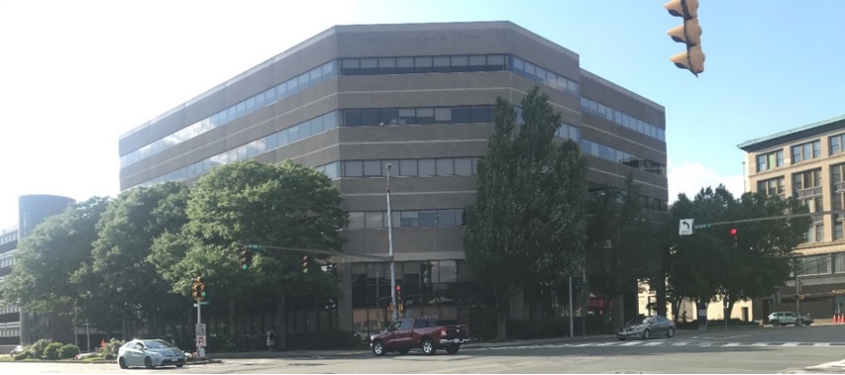
Figure 5
Walgreens on Southwest Corner of Intersection
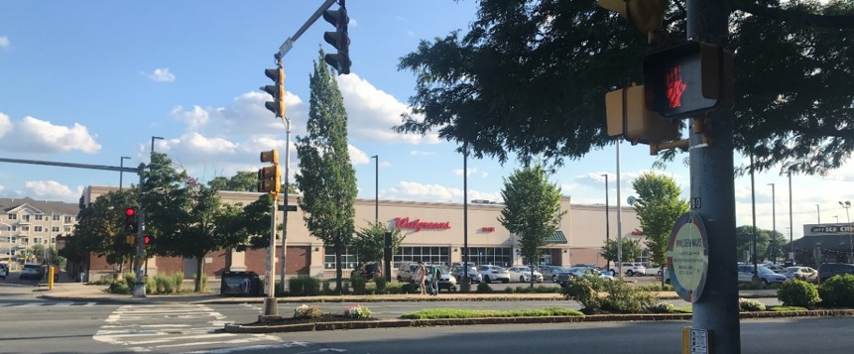
There are many curb cuts for parking lots within the vicinity of the study intersection, but the majority of the curb cuts only extend for the width required to accommodate one entering and one exiting vehicle. Sidewalk height remains relatively constant through the driveways, as opposed to dipping to meet roadway level, which helps to communicate that the area is a pedestrian zone, increasing driver awareness and pedestrian safety (Figure 6).
Figure 6
Driveways to the Walgreens parking lot maintain a constant sidewalk height, communicating the area is a pedestrian zone. The narrow driveway widths and the tight turning radii encourage greater driver attention and slow vehicle travel speeds.
Source: Google Street View
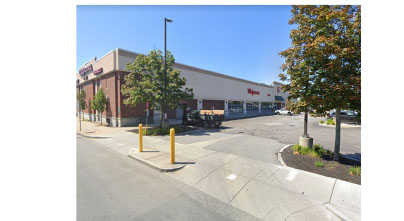
Sidewalks run along both sides of every approach to the intersection, all exceeding the American with Disabilities Act (ADA) minimum width of five feet. Fading ladder-style crosswalks mark each crossing with solid white lines between two parallel solid white lines (Figure 7). Apex curb ramps are located at each of the intersection’s four corners. There are no bicycle facilities along either roadway.
The pedestrian signal push buttons at each corner are Accessible Pedestrian Signals (APS), meaning they include tactile and audible components to communicate to hearing- or vision-impaired users when it is safe to cross the intersection.
The intersection’s concurrent pedestrian phases are push-button actuated. There are two, one-section pedestrian signal heads at each corner that feature a 12-inch LED symbols display and include countdown displays for the pedestrian Flashing Don’t Walk phase.
FIGURE 7
All four curb ramps are apex, as pictured here looking north along the intersection’s west leg from the southwest corner.
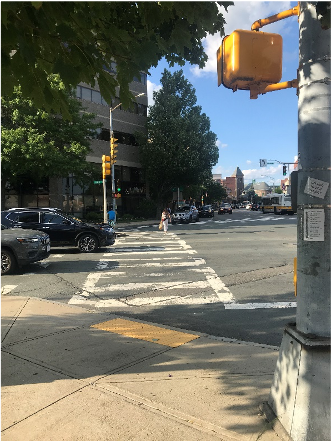
There is a bus stop for routes 99, 104, 105, and 106 outbound at the intersection, and all four inbound routes pass through the location as well. The outbound bus stop is located on the northbound lane of Main Street, just south of the Centre Street intersection. Centre Street does not include on-street parking. Main Street, however, features on-street parking south of the intersection and one block north of the study location.
The biggest concern at the Centre Street and Main Street intersection is that it is located within an HSIP-eligible pedestrian crash cluster. While there are pedestrian accommodations such as sidewalks and pedestrian signals at the intersection, there are several elements in need of improvement.
Sidewalks meeting minimum width requirements are present throughout the area and they are generally in a good state of repair. In some locations, however, the sidewalks are cracked or feature vegetation growing up between the slabs of concrete, suggesting the presence of gaps that could impede travel for people with mobility impairments (Figure 8).
FIGURE 8
Vegetation grows between the concrete sidewalk slabs outside of the Verizon store on the northeast corner of the intersection.
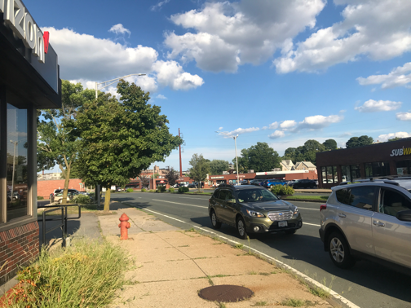
Although there are curb ramps with truncated dome detectable warnings at all four corners of the Centre Street and Main Street intersection, they are all apex ramps, which direct users to travel into the middle of the intersection instead of directly along a crosswalk (Figure 9).
The pedestrian signal push buttons are difficult to actuate. This may be a product of the button design or a result of use.
FIGURE 9
Apex curb ramp on the southwest corner of the intersection directing pedestrians into the middle of traffic instead of along the path of either crosswalk.

During peak travel hours, staff observed traffic backing up on Main Street north of the intersection. This appears to be influenced by the traffic signal one block north of Centre Street, where Main Street meets Exchange Street/Irving Street (Figure 10). This can make it difficult for bicyclists and pedestrians to cross the north and east legs of the intersection.
FIGURE 10
Traffic backed up on Main Street north of the intersection.

Staff observed fading along the crosswalks for all four legs of the intersection, although the crosswalk markings across the west leg of the intersection are more faded than the others (Figure 11).
Current intersection geometry at all four corners create wide turning radii, which allow vehicles to take quick turns and make it more difficult to see pedestrians waiting to cross the intersection.
FIGURE 11
Fading crosswalk markings across the west leg of the intersection.
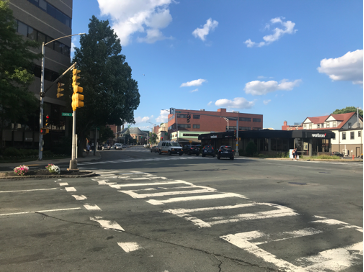
The lack of bicycle facilities in the area leads pedestrians and bicyclists to share sidewalk space. This is particularly troublesome given the pedestrian volumes during peak travel hours (Figure 12).
Staff did not observe bicycle racks within the vicinity of the Centre Street and Main Street intersection.
FIGURE 12
A bicyclist and pedestrian begin to cross the intersection after sharing sidewalk space while waiting for the pedestrian signal.
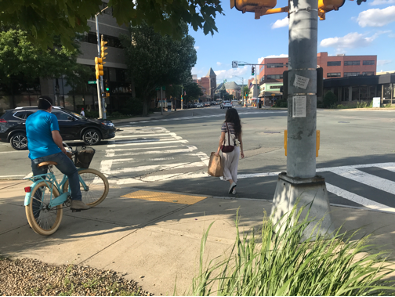
On August 6, 2020, during one hour of peak PM travel, MPO staff counted 92 pedestrians and 21 bicyclists. Staff observed the greatest number of pedestrians traveling southward on the western side of the intersection, toward the direction of Walgreens from the northwest corner where Commerce Place is located. Many bicyclists observed at the intersection were traveling along the sidewalks.
MPO staff graded the intersection of Main Street and Centre Street in Malden using the Boston Region MPO’s Pedestrian Report Card Assessment (PRCA) and Bicycle Report Card tools to assess the safety and comfort of the area for people walking and bicycling. 3 The grading categories reflect the MPO’s Long-Range Transportation Plan (LRTP) goals and assess the quality of four different aspects of the environment: Capacity Management and Mobility, Economic Vitality, Safety, and System Preservation. The report cards also prioritize locations based on Transportation Equity factors, incorporating another Boston region LRTP goal.
Figure 13
Signalized Intersection PRCA for Main Street and Centre Street in Malden
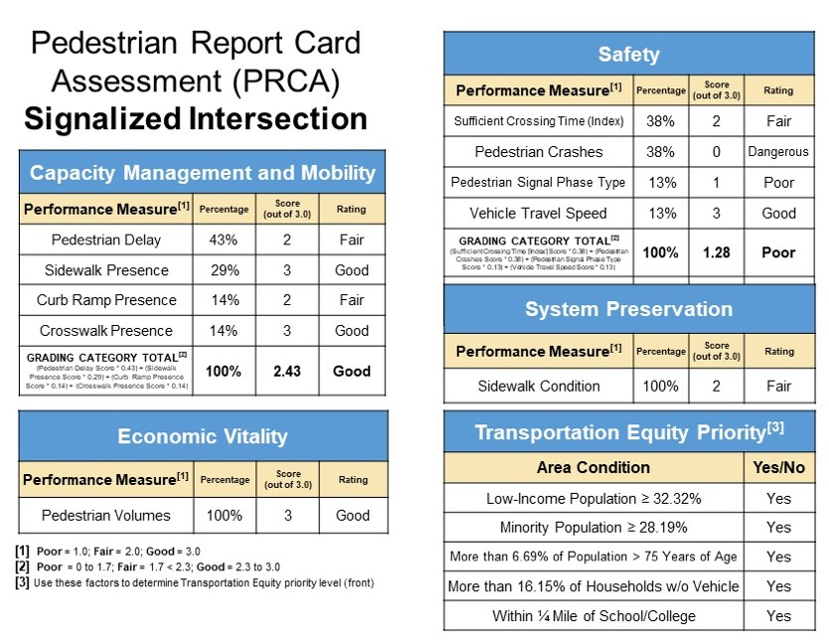
The intersection scored well for pedestrians in the subjects of Capacity Management and Mobility and Economic Vitality. This is due to plentiful, wide sidewalks at the intersection, the presence of marked crosswalks across every leg, and the fact that many pedestrians travel through the location. The current pedestrian delay, which is the amount of time a pedestrian waits in the signal cycle for the pedestrian crossing phase, of approximately 28 seconds is decent but could be improved. The curb ramps with truncated domes at each corner of the intersection are a good start, but all four are apex ramps.
The intersection’s score sharply drops for Safety because of (1) its location in an HSIP-eligible crash cluster and (2) the fact that the pedestrian crossing phase is concurrent with vehicle traffic without including a Leading Pedestrian Interval (LPI) or No Right Turn on Red signage to minimize conflicts between motorists and pedestrians. The amount of time provided for pedestrians to cross the intersection receives a “Fair” grade because it allows pedestrians to travel at a speed of 3.32 feet per second across the intersection’s longest leg, which is approximately 95 percent of the Federal Highway Administration maximum crossing speed of 3.5 feet per second. This guidance aims to provide sufficient time for all users to complete an intersection crossing. Vehicle travel speed is considered good at the intersection of Centre Street and Main Street because the average does not exceed 25 miles per hour.
Sidewalk condition is fair at the location because, although segments of concrete are in need of repair, the sidewalks themselves are of sufficient width and located on both sides of all four intersection legs. Finally, the intersection is considered a High Priority area for pedestrian transportation equity because the proportions of all four populations (low-income, minority, elderly, and zero-vehicle households) at the location exceed their regional averages and the intersection is located within a quarter mile of a school.
Figure 14
Bicycle Report Card for Main Street and Centre Street in Malden
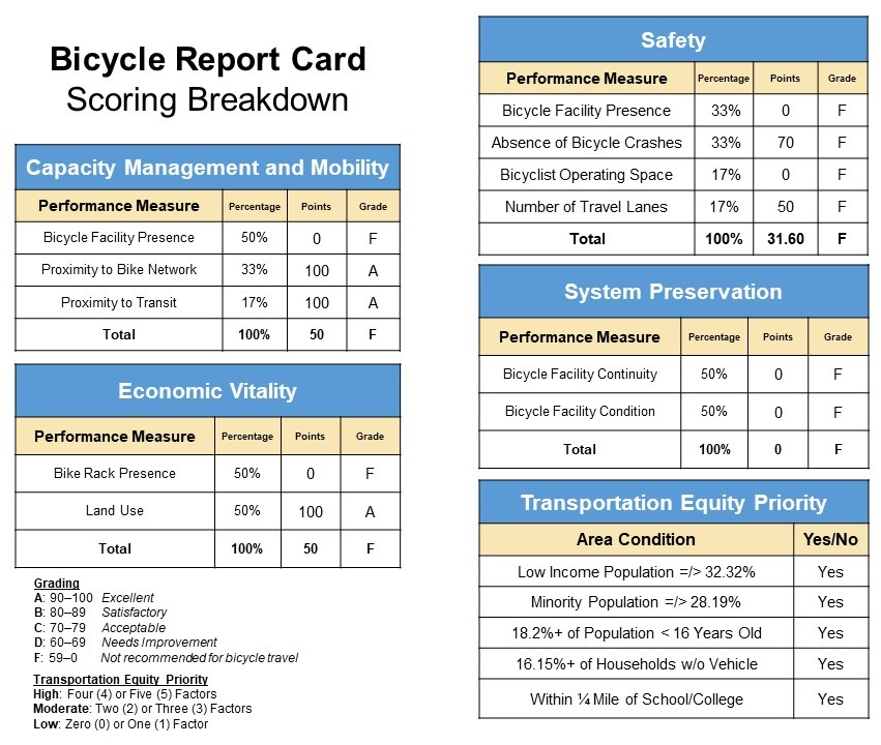
The intersection of Main Street and Centre Street received a failing score for all four Bicycle Report Card grading categories. The lack of bicycle facilities played a large factor in the ratings. In Capacity Management and Mobility, this absence outweighed the fact that there is a bus stop at the intersection to satisfy the half mile Proximity to Transit metric and, at less than one-tenth of a mile north of the Northern Strand Community Path, the intersection is within one-quarter mile of bicycle facilities.
In the Economic Vitality category, the absence of bicycle racks effectively negates the value of the diverse land uses at the location, which create many origins and destinations for bicyclists within the study area.
All four legs approaching the Centre Street and Main Street intersection feature three lanes of traffic, with three of the legs separated by a median from motorists traveling in the opposite direction. This earned the location a failing grade of 50 for the Number of Travel Lanes performance metric. There was one bicycle crash from 2013–17 at the intersection, resulting in the location’s failing score of 70 for “Absence of Bicycle Crashes.” The lack of bicycle facilities at the intersection and the associated absence of bicyclist operating space along both roadways additionally contribute to the location’s failing Safety score.
Without bicycle facilities at the location, it was impossible for either roadway to earn points for bicycle System Preservation, which led to another failing grade. Finally, the intersection is considered a High Priority area for pedestrian transportation equity because the proportions of all four populations (low-income, minority, youth, and zero-vehicle households) at the location exceed their regional averages and the intersection is located within one-quarter mile of a school.
Forty-nine crashes were recorded over the five-year period between 2013 and 2017. Table 1 breaks these crashes down by type of collision, severity, and factors that may have influenced the crash. One crash involved bicyclists and seven crashes involved pedestrians. All eight crashes with nonmotorists were single vehicle collisions that occurred in dry conditions. Two pedestrian-involved crashes happened during peak evening travel times, but the remaining collisions involving nonmotorists all occurred during off-peak travel hours.
Table 1
2013–17 Crash Summary
Crash Variable |
Number of Total Crashes |
Number of Vehicle-Only Crashes |
Number of Pedestrian-Involved Crashes |
Number of Bicyclist-Involved Crashes |
Crash Severity |
-- |
-- |
-- |
-- |
Nonfatal Injury |
14 |
10 |
4 |
0 |
Property Damage Only |
30 |
26 |
3 |
1 |
Not Reported |
5 |
5 |
0 |
0 |
Total Crashes |
49 |
41 |
7 |
1 |
Type of Collision |
-- |
-- |
-- |
-- |
Angle |
17 |
16 |
1 |
0 |
Rear-End |
16 |
16 |
0 |
0 |
Sideswipe, Same Direction |
6 |
6 |
0 |
0 |
Single Vehicle Crash |
9 |
2 |
6 |
1 |
Not Reported |
1 |
1 |
0 |
0 |
Total Crashes |
49 |
41 |
7 |
1 |
Road Surface Condition |
-- |
-- |
-- |
-- |
Dry |
32 |
24 |
7 |
1 |
Snow |
3 |
3 |
0 |
0 |
Slush |
1 |
1 |
||
Wet |
12 |
12 |
0 |
0 |
Not Reported |
1 |
1 |
0 |
0 |
Total Crashes |
49 |
41 |
7 |
1 |
Ambient Light Condition |
-- |
-- |
-- |
-- |
Daylight |
25 |
20 |
4 |
1 |
Dusk |
1 |
0 |
1 |
0 |
Dark—Lighted Roadway |
21 |
19 |
2 |
0 |
Dark—Roadway Not Lighted |
1 |
1 |
0 |
0 |
Not Reported |
1 |
1 |
0 |
0 |
Total Crashes |
49 |
41 |
7 |
1 |
Weather Condition |
-- |
-- |
-- |
-- |
Clear |
30 |
23 |
6 |
1 |
Cloudy |
7 |
6 |
1 |
0 |
Rain |
6 |
6 |
0 |
0 |
Sleet |
1 |
1 |
0 |
0 |
Snow |
4 |
4 |
0 |
0 |
Not Reported/Unknown |
1 |
1 |
0 |
0 |
Total Crashes |
49 |
41 |
7 |
1 |
Travel Period |
-- |
-- |
-- |
-- |
Peak AM* |
4 |
2 |
2 |
0 |
Peak PM* |
9 |
7 |
2 |
0 |
Off-Peak |
36 |
32 |
3 |
1 |
Total Crashes |
49 |
41 |
7 |
1 |
Five-Year Average |
9.8 |
8.2 |
1.4 |
0.2 |
* Peak periods are defined as 6:00–9:00 AM and 3:00–6:00 PM
Some highlights of the data include:
MPO staff also prepared a collision diagram for the study intersection to examine crash patterns. Police reports were obtained for the years 2013–17. Figure 15 shows the collision diagram. The index numbers in the collision diagram may be used to cross-reference the crash records in Appendix B. The index numbers with circles around them refer to injury or fatal crashes, depending on the thickness of the circle line.
Figure 15
Collision Diagram: MassDOT Crash Data 2013–17
Main Street and Centre Street Intersection in Malden
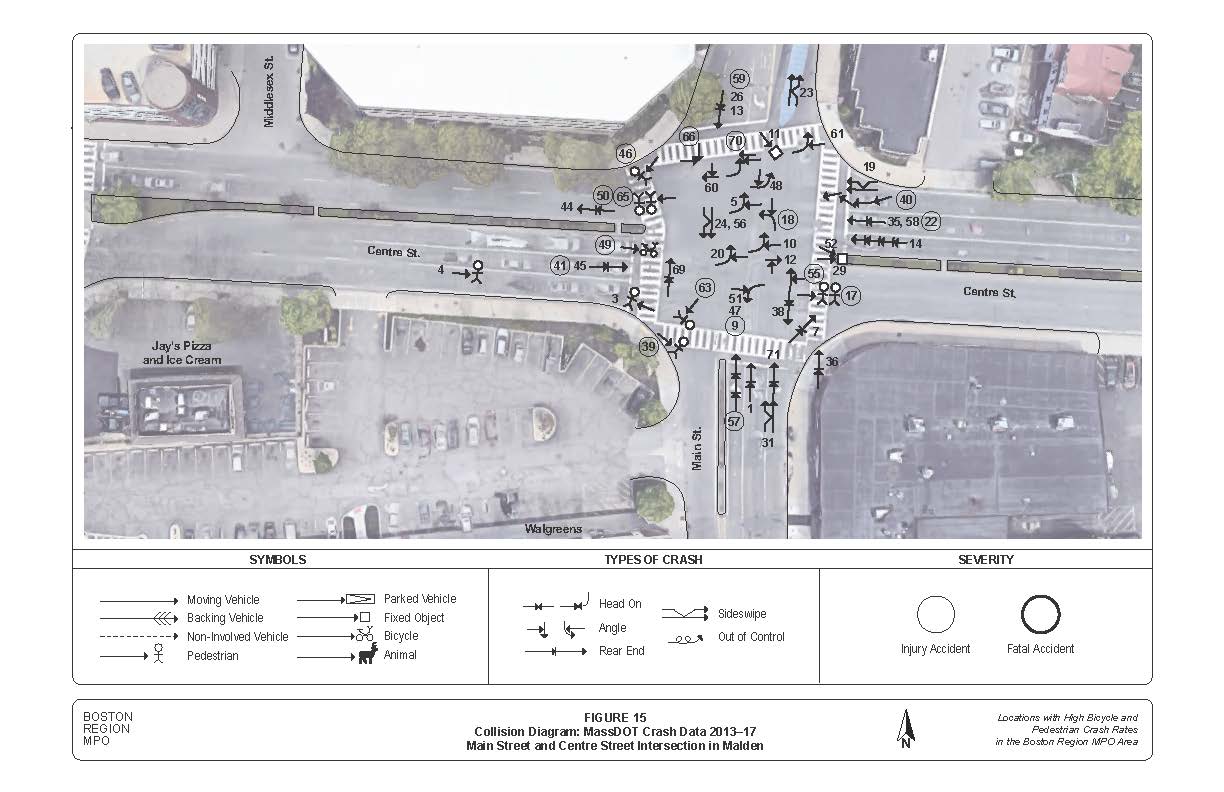
After analyzing the collision data, MPO staff concluded that crashes within the study area primarily appear to be caused by confusion and lack of visibility. Every pedestrian-involved crash for which police provided information about the nonmotorists at the time of the collision stated that the pedestrians were either entering or crossing a specified location or in a marked crosswalk at the intersection. The danger to pedestrians at this intersection may be attributed to two key factors:
TABLE |
||||
Crash Summary (2013-17): Centre Street and Main Street Intersection |
||||
Crash Variable |
Total Number of Intersection Crashes |
Number of Vehicle/Vehicle Crashes |
Number of Crashes Involving Pedestrians |
Number of Crashes Involving Bicyclists |
Crash Severity |
||||
Incapacitating Injury |
1 |
0 |
1 |
0 |
Non-Incapacitating Injury |
8 |
6 |
2 |
0 |
Injury Possible |
6 |
5 |
1 |
0 |
No injury |
32 |
28 |
3 |
1 |
Not Applicable / Reported |
7 |
7 |
0 |
0 |
54 |
46 |
7 |
1 |
|
Manner of Collision |
||||
Angle |
17 |
16 |
1 |
0 |
Rear-End |
19 |
19 |
0 |
0 |
Rear to Rear |
3 |
3 |
0 |
0 |
Sideswipe, Same Direction |
6 |
6 |
0 |
0 |
Single Vehicle Crash |
9 |
2 |
6 |
1 |
Unknown / Not Reported |
0 |
0 |
0 |
0 |
54 |
46 |
7 |
1 |
|
Road surface condition |
||||
Dry |
36 |
28 |
7 |
1 |
Snow / Slush |
4 |
4 |
0 |
0 |
Wet |
12 |
12 |
0 |
0 |
Not Reported /Unknown |
2 |
2 |
0 |
0 |
54 |
46 |
7 |
1 |
|
Ambient Light Condition |
||||
Daylight |
27 |
22 |
4 |
1 |
Dusk |
1 |
0 |
1 |
0 |
Dark-Lighted Roadway |
23 |
21 |
2 |
0 |
Dark-Roadway Not Lighted |
1 |
1 |
0 |
0 |
Not Reported/Other/Unknown |
2 |
2 |
0 |
0 |
54 |
46 |
7 |
1 |
|
Weather Condition |
||||
Clear |
33 |
26 |
6 |
1 |
Cloudy |
8 |
7 |
1 |
0 |
Rain |
5 |
5 |
0 |
0 |
Sleet |
1 |
1 |
0 |
0 |
Snow |
5 |
5 |
0 |
0 |
Not Reported / Unknown |
2 |
2 |
0 |
0 |
54 |
46 |
7 |
1 |
|
Travel Period |
||||
Peak AM |
4 |
0 |
0 |
0 |
Peak PM |
8 |
0 |
2 |
0 |
Off-Peak |
42 |
46 |
5 |
1 |
54 |
46 |
7 |
1 |
|
Five-Year Crash Average |
10.8 |
|||
One improvement that would help all users at the intersection is the proper trimming of vegetation for purposes of visibility. In particular, overgrown tree branches outside Commerce Place may obscure the view of traffic signals.
Pedestrian Improvements
Bicycle Improvements
Figure 16
Proposed Improvements Conceptual Plan
Main Street and Center Street
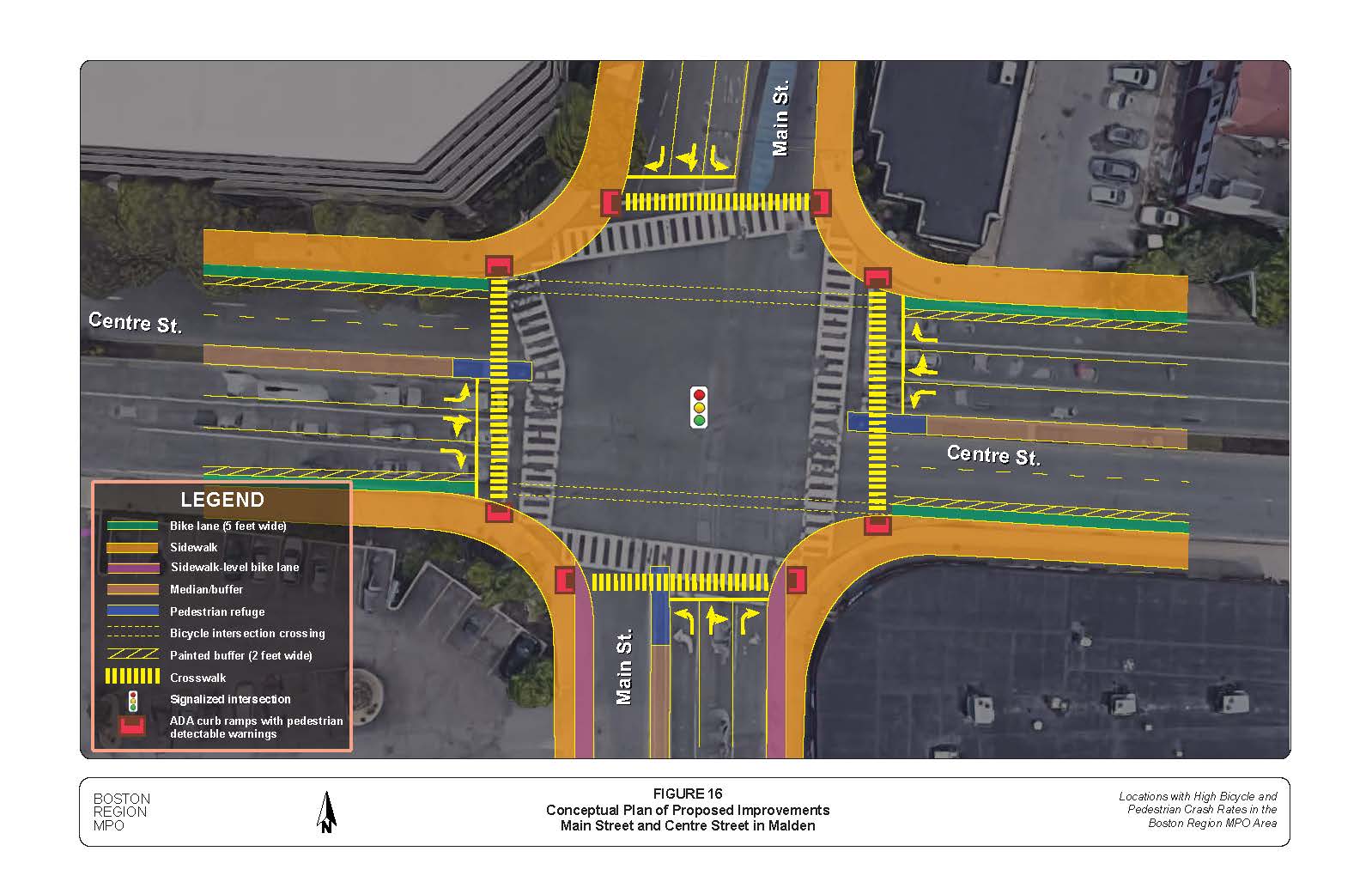
The above evaluations and recommendations support the need for improvements that would enhance bicycle and pedestrian safety and comfort at the intersection of Main Street and Centre Street in Malden. All of the suggestions address concerns related to crashes involving people walking or bicycling. Although MPO staff were not able to analyze traffic volumes and assess travel patterns because of variations in travel behavior resulting from the COVID-19 pandemic, this memorandum presents several approaches that the City of Malden could take to improve the quality of the pedestrian and bicyclist environment at this intersection without significantly affecting other modes of travel.
As traffic patterns return to their previous levels over the coming months and years, Malden should consider documenting the motorists, bicyclists, pedestrians, and other users who regularly travel through the intersection of Main Street and Centre Street. A better understanding of travel volumes by mode and turning movements would be helpful for completing applications for regional, state, and federal funding to support infrastructure improvements. If future assessments of the intersection determine that the location would benefit from geometric reconfiguration or the installation of new infrastructure for bicycle and pedestrian safety, Malden may consider applying for Transportation Improvement Program funding through the Boston Region MPO.
The Boston Region Metropolitan Planning Organization (MPO) operates its programs, services, and activities in compliance with federal nondiscrimination laws including Title VI of the Civil Rights Act of 1964 (Title VI), the Civil Rights Restoration Act of 1987, and related statutes and regulations. Title VI prohibits discrimination in federally assisted programs and requires that no person in the United States of America shall, on the grounds of race, color, or national origin (including limited English proficiency), be excluded from participation in, denied the benefits of, or be otherwise subjected to discrimination under any program or activity that receives federal assistance. Related federal nondiscrimination laws administered by the Federal Highway Administration, Federal Transit Administration, or both, prohibit discrimination on the basis of age, sex, and disability. The Boston Region MPO considers these protected populations in its Title VI Programs, consistent with federal interpretation and administration. In addition, the Boston Region MPO provides meaningful access to its programs, services, and activities to individuals with limited English proficiency, in compliance with U.S. Department of Transportation policy and guidance on federal Executive Order 13166. The Boston Region MPO also complies with the Massachusetts Public Accommodation Law, M.G.L. c 272 sections 92a, 98, 98a, which prohibits making any distinction, discrimination, or restriction in admission to, or treatment in a place of public accommodation based on race, color, religious creed, national origin, sex, sexual orientation, disability, or ancestry. Likewise, the Boston Region MPO complies with the Governor's Executive Order 526, section 4, which requires that all programs, activities, and services provided, performed, licensed, chartered, funded, regulated, or contracted for by the state shall be conducted without unlawful discrimination based on race, color, age, gender, ethnicity, sexual orientation, gender identity or expression, religion, creed, ancestry, national origin, disability, veteran's status (including Vietnam-era veterans), or background. A complaint form and additional information can be obtained by contacting the MPO or at http://www.bostonmpo.org/mpo_non_discrimination. To request this information in a different language or in an accessible format, please contact Title VI Specialist |
1 An HSIP eligible cluster is one in which the total number of Equivalent Property Damage Only (EPDO) crashes is within the top five percent in the region. EPDO is a method of combining the number of crashes with the severity of crashes based on a weighted scale. Prior to 2016 the weighting factors used were as follows: a fatal crash was worth 10 points, an injury crash was worth 5 points, and a property-damage only crash was worth 1 point. Starting in 2016, the weighting factors were updated so that fatal and injury crashes are worth 21 and a property-damage only crash is worth 1. An HSIP eligible pedestrian crash cluster has an EPDO within the top five percent of all pedestrian crash clusters in the region.
2 A TAZ is the unit of geography most commonly used in conventional transportation planning models for tabulating transportation-related data. A TAZ usually consists of one or more census blocks, block groups, or census tracts. A map of the Boston region’s TAZs can be found
at https://www.ctps.org/node/3122.
3 Ryan Hicks and Casey-Marie Claude, “Pedestrian Level-of-Service,” Boston Region Metropolitan Planning Organization, January 2017. https://www.ctps.org/ped-report-card. (Updated 2019: Casey-Marie Claude, “Pedestrian Report Card Assessment Interactive Database,” Boston Region Metropolitan Planning Organization, November 2019. https://www.ctps.org/data/pdf/programs/bike_ped/prca_app/2019-11-21_PRCA_Interactive_Database.pdf.); Casey-Marie Claude, “Development of a Scoring System for Bicycle Travel in the Boston Region,” Boston Region Metropolitan Planning Organization, November 2018. https://www.ctps.org/bicycle-level-of-service.
4 Otak, Inc., “Accessible Public Rights-of-Way: Planning and Designing for Alterations; Chapter 6—Curb Ramp Examples” United States Access Board, August 2007. https://www.access-board.gov/prowag/planning-and-design-for-alterations/chapter6/.
5 Association of Pedestrian and Bicycle Professionals, “Essentials of Bike Parking: Selecting and Installing Bike Parking that Works,” September 2015. https://www.apbp.org/assets/docs/EssentialsofBikeParking_FINA.pdf.
Appendices